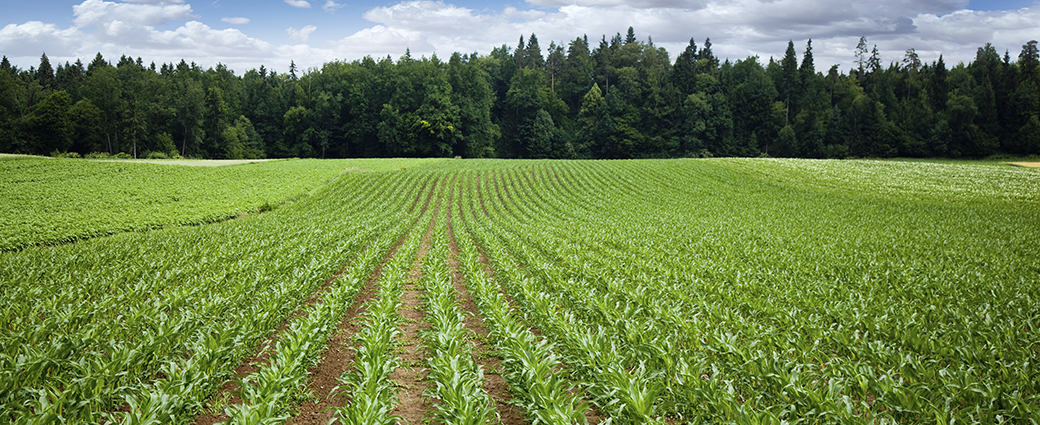Timberland and farmland: real assets with complementary investment attributes
Timberland and farmland are attractive long-term investments that have historically delivered capital preservation, strong performance, a current income return component, low-to-moderate risk, and favorable diversification characteristics. We demonstrate how the inclusion of timberland and farmland investment strategies widens the investable universe and increases the opportunity set while providing a range of options to meet specific investment objectives.

Timberland and farmland: an overview
Timberland and farmland are both income-generating and land-appreciation investments with a biological growth component. Demographic growth and economic expansion increase demand for food and shelter and are the foundation of some key revenue streams associated with timberland and farmland investments. The increase in worldwide per capita GDP and population, along with continuing migration from rural to urban areas, contributes to the growing demand for farm and forest products. However, since the supply of commercially operable timberland and farmland is limited, global population growth and ongoing urbanization will increase pressures to cultivate farm crops and manage timber plantations in the most efficient and environmentally sustainable manner.
Both timberland and farmland investments offer comparably attractive risk-adjusted returns and the ability to hedge inflation. Historically, investments in timberland have provided total real returns (net of inflation) of 4% to 10% and nominal returns of 7% to 13%. Historical total nominal returns for investments in farmland have ranged from 6% to 13%, or 4% to 9% adjusted for inflation, with nominal income returns ranging from 5% to 8%. Historically, timberland and farmland have shown measurable similarities in their financial performance.
Timberland and farmland can play a role in improving the overall performance of a mixed-asset portfolio through diversification due to their low positive and negative correlations with traditional financial assets. Timberland and farmland returns have maintained an average correlation of approximately 0.63 with each other over the past 25 years, a positive, but not perfect, correlation.
The U.S. market is the deepest and most active market worldwide for timberland, agriculture, and other real assets. Institutional investors who participate in the National Council of Real Estate Investment Fiduciaries (NCREIF) indexes owned approximately $23.2 billion of prime U.S. timberland and $11.4 billion of U.S. farmland real estate as of December 2019. Since 1991,¹ NCREIF has maintained and tracked real asset indexes, which provide the most consistent performance record for each respective class; these values are U.S.-centric and provide direct insight for the U.S. market. Applying this analysis, internal expertise, and, more recently, available data allows us to make assumptions concerning global and country-specific performance.
Growing diversification with timberland and farmland
We believe that timberland and farmland are attractive long-term investments that have historically delivered capital preservation, historically strong performance, a current income return component, low-to-moderate risk, and favorable diversification characteristics. In our view, adding timberland and farmland investment strategies to a portfolio broadens the investment universe, while a global investment approach allows greater flexibility in investing capital by taking advantage of differences in regional market dynamics; uncorrelated markets in expanded investable universes may also provide diversification benefits.
Timberland and farmland have also historically provided a relatively high rate of return for the associated level of risk compared with other asset classes.
Risk-adjusted returns for real assets, as measured by the Sharpe ratio, have been strong over the past 25 years. Farmland achieved the strongest risk-adjusted performance with a Sharpe ratio of 1.30, followed by commercial real estate, private equity, and timberland at 0.94, 0.86, and 0.71, respectively.
Putting it to work: timberland and farmland performance through the decades
Timberland and farmland have historically tended to perform differently under specific economic and policy conditions. To illustrate the differences in performance between them, we compared performance in three time periods and included commercial real estate returns as an additional point of reference. Commercial real estate is a real asset that shares certain similar attributes and moderately positive return correlations with timberland and farmland, although there are distinct differences as well. The first period of the three, 1976 to 1990, is the earliest period during which synthetic returns were available for timberland and farmland, 1991 to 2009 covers the period during which NCREIF-reported returns became available for all three asset classes, and, finally, 2010 to 2019 comprises the post-global financial crisis (GFC) period.
Over extended periods of time, nominal total property-level returns for timberland, farmland, and commercial real estate have, on average, ranged from high single digits to low double digits. In the first period, timberland returned an average of 15.2%, its strongest performance for all three periods, while farmland registered its lowest average returns. This period included the 1980s farm crisis recession, while timberland returns benefited from the increasing monetization of forest product companies’ land holdings, booming log exports to Japan, and a cyclical peak in the housing market. In the decade and a half leading up to the GFC, timberland and farmland posted moderate returns of 12.2% and 11.3%, respectively.
In the wake of the GFC, timberland returns dropped sharply, to an average of 4.5%, reflecting a historic collapse in U.S. residential construction activity and an exceptionally lackluster housing recovery in the post-GFC period. However, farmland returns were exceptionally strong following the GFC, averaging 11.1%, showing limited vulnerability to the global economic slowdown. Factors supporting robust returns for farmland investments included U.S. government-mandated use of ethanol in car fuel and trade restrictions limiting U.S. imports of ethanol, historically high commodity prices fueled in part by drought conditions in U.S. row crops in the Midwest and strong Chinese imports of agricultural commodities, including higher-value permanent crops such as almonds and pistachios.
The return information in the chart above is summarized in the following table and illustrates the complementary nature of timberland and farmland in a well-diversified portfolio.
Building a diversified portfolio to manage macro and market risk factors
Similar to commercial real estate and financial assets, farmland and timberland are vulnerable to macroeconomic and market risk factors. In the case of timberland, residential construction activity is a key source of demand and a dominant value driver for many investments. The cyclicality of housing demand can result in pronounced swings in timber prices, but timberland owners often have the capability to allow their trees to continue growing and defer their harvest operations to coincide with stronger market conditions. For farmland investments, the dynamics of international trade are an important consideration, including shifts in foreign exchange rates and cross-country trade agreements. Timberland and farmland encompass a wide array of forest and crop types (row and permanent) that produce for a multitude of end-use markets. With a wide range of investment options, timberland and farmland investors can build a diversified portfolio of properties to help insulate their exposure to many risk factors.
In addition to market and macro risk factors, timberland and farmland investments are also exposed to the possibility of physical crop damage resulting from weather, pests, and disease. These physical-casualty risks generally account for a relatively small proportion of annual revenue and can be proactively addressed through management practices in the operation of the farms and timber plantations, crop insurance for agricultural properties, and, most important, geographic diversification in portfolio construction. In most cases, the impacts of weather events (droughts, floods, hurricanes, etc.) and outbreaks of diseases or pests are location specific. In our view, a geographically diverse portfolio of properties mitigates and limits the associated damage of these physical risks; in addition, the restricted supply resulting from these physical-casualty events often has an offsetting positive impact on product pricing in the affected area.
Our review of the historical performance and investment characteristics of timberland and farmland suggests that incorporating these two asset classes into a broad institutional portfolio has the potential to deliver strong risk-adjusted returns, while a global investment approach that takes advantage of regional dynamics can provide further diversification benefits.
1 Timberland (1987) and commercial real estate (1978) property-level NCREIF data dates back further. The NCREIF Farmland Index was created in 1991 and serves as the earliest common date range for this analysis.
Important information
Historical annual total return performance for private farmland, timberland, and commercial real estate is sourced from the National Council of Real Estate Investment Fiduciaries (NCREIF) property-level indexes for U.S. commercial real estate, U.S. farmland, and U.S. timberland. The construction methodology for these before-fee, nominal U.S. indexes can be found at ncreif.org. Historical timberland performance from 1976 to 1986 is sourced from Hancock Natural Resource Group synthetized John Hancock Timberland Index. Historical farmland performance from 1976 to 1990 is constructed and sourced from Ibbotson Associates. Historical annual total return performance for publicly traded equities is represented by the S&P 500 Index, which tracks the performance of 500 of the largest publicly traded companies in the United States. Small-cap U.S. equities are represented by IA SBBI U.S. Small Stock indexes, published by Morningstar Ibbotson. Long-term corporate bonds are represented by Morningstar Ibbotson’s IA SBBI U.S. Long-Term Corporate series. International equities are represented by the MSCI Europe, Australasia, and Far East Index, which tracks the performance of publicly traded large-and mid-cap stocks of companies in these regions. Commodity total returns are represented by the Goldman Sachs Commodity Index. Infrastructure total returns are represented by the Preqin Infrastructure Index. It is not possible to invest directly in an index. Past performance does not guarantee future results.
A widespread health crisis such as a global pandemic could cause substantial market volatility, exchange-trading suspensions and closures, and affect portfolio performance. For example, the novel coronavirus disease (COVID-19) has resulted in significant disruptions to global business activity. The impact of a health crisis and other epidemics and pandemics that may arise in the future could affect the global economy in ways that cannot necessarily be foreseen at the present time. A health crisis may exacerbate other preexisting political, social, and economic risks. Any such impact could adversely affect the portfolio’s performance, resulting in losses to your investment
Investing involves risks, including the potential loss of principal. Financial markets are volatile and can fluctuate significantly in response to company, industry, political, regulatory, market, or economic developments. These risks are magnified for investments made in emerging markets. Currency risk is the risk that fluctuations in exchange rates may adversely affect the value of a portfolio’s investments.
The information provided does not take into account the suitability, investment objectives, financial situation, or particular needs of any specific person. You should consider the suitability of any type of investment for your circumstances and, if necessary, seek professional advice.
This material, intended for the exclusive use by the recipients who are allowed to receive this document under the applicable laws and regulations of the relevant jurisdictions, was produced by, and the opinions expressed are those of, Manulife Investment Management as of the date of this publication and are subject to change based on market and other conditions. The information and/or analysis contained in this material has been compiled or arrived at from sources believed to be reliable, but Manulife Investment Management does not make any representation as to their accuracy, correctness, usefulness, or completeness and does not accept liability for any loss arising from the use of the information and/or analysis contained. The information in this material may contain projections or other forward-looking statements regarding future events, targets, management discipline, or other expectations, and is only as current as of the date indicated. The information in this document, including statements concerning financial market trends, are based on current market conditions, which will fluctuate and may be superseded by subsequent market events or for other reasons. Manulife Investment Management disclaims any responsibility to update such information.
Neither Manulife Investment Management or its affiliates, nor any of their directors, officers, or employees, shall assume any liability or responsibility for any direct or indirect loss or damage or any other consequence of any person acting or not acting in reliance on the information contained herein. All overviews and commentary are intended to be general in nature and for current interest. While helpful, these overviews are no substitute for professional tax, investment, or legal advice. Clients should seek professional advice for their particular situation. Neither Manulife, Manulife Investment Management, nor any of their affiliates or representatives is providing tax, investment, or legal advice. This material was prepared solely for informational purposes; does not constitute a recommendation, professional advice, an offer, or an invitation by or on behalf of Manulife Investment Management to any person to buy or sell any security or adopt any investment strategy; and is no indication of trading intent in any fund or account managed by Manulife Investment Management. No investment strategy or risk management technique can guarantee returns or eliminate risk in any market environment. Diversification or asset allocation does not guarantee a profit or protect against a loss in any market. Unless otherwise specified, all data is sourced from Manulife Investment Management. Past performance does not guarantee future results.
Manulife Investment Management
Manulife Investment Management is the global wealth and asset management segment of Manulife Financial Corporation. We draw on more than a century of financial stewardship to partner with clients across our institutional, retail, and retirement businesses globally. Our specialist approach to money management includes the highly differentiated strategies of our fixed-income, specialized equity, multi-asset solutions, and private markets teams, along with access to specialized, unaffiliated asset managers from around the world through our multimanager model.
This material has not been reviewed by and is not registered with any securities or other regulatory authority, and may, where appropriate, be distributed by the following Manulife entities in their respective jurisdictions. Additional information about Manulife Investment Management may be found at manulifeim.com/institutional.
Australia: Hancock Natural Resource Group Australasia Pty Limited, Manulife Investment Management (Hong Kong) Limited. Brazil: Hancock Asset Management Brasil Ltda. Canada: Manulife Investment Management Limited, Manulife Investment Management Distributors Inc., Manulife Investment Management (North America) Limited, Manulife Investment Management Private Markets (Canada) Corp. China: Manulife Overseas Investment Fund Management (Shanghai) Limited Company. European Economic Area and United Kingdom: Manulife Investment Management (Europe) Ltd., which is authorized and regulated by the Financial Conduct Authority; Manulife Investment Management (Ireland) Ltd., which is authorized and regulated by the Central Bank of Ireland. Hong Kong: Manulife Investment Management (Hong Kong) Limited. Indonesia: PT Manulife Aset Manajemen Indonesia. Japan: Manulife Investment Management (Japan) Limited. Malaysia: Manulife Investment Management (M) Berhad (formerly known as Manulife Asset Management Services Berhad) 200801033087 (834424-U). Philippines: Manulife Asset Management and Trust Corporation. Singapore: Manulife Investment Management (Singapore) Pte. Ltd. (Company Registration No. 200709952G). South Korea: Manulife Investment Management (Hong Kong) Limited. Switzerland: Manulife IM (Switzerland) LLC. Taiwan: Manulife Investment Management (Taiwan) Co. Ltd. United States: John Hancock Investment Management LLC, Manulife Investment Management (US) LLC, Manulife Investment Management Private Markets (US) LLC, and Hancock Natural Resource Group, Inc. Vietnam: Manulife Investment Fund Management (Vietnam) Company Limited.
Manulife Investment Management, the Stylized M Design, and Manulife Investment Management & Stylized M Design are trademarks of The Manufacturers Life Insurance Company and are used by it, and by its affiliates, under license.
523451



